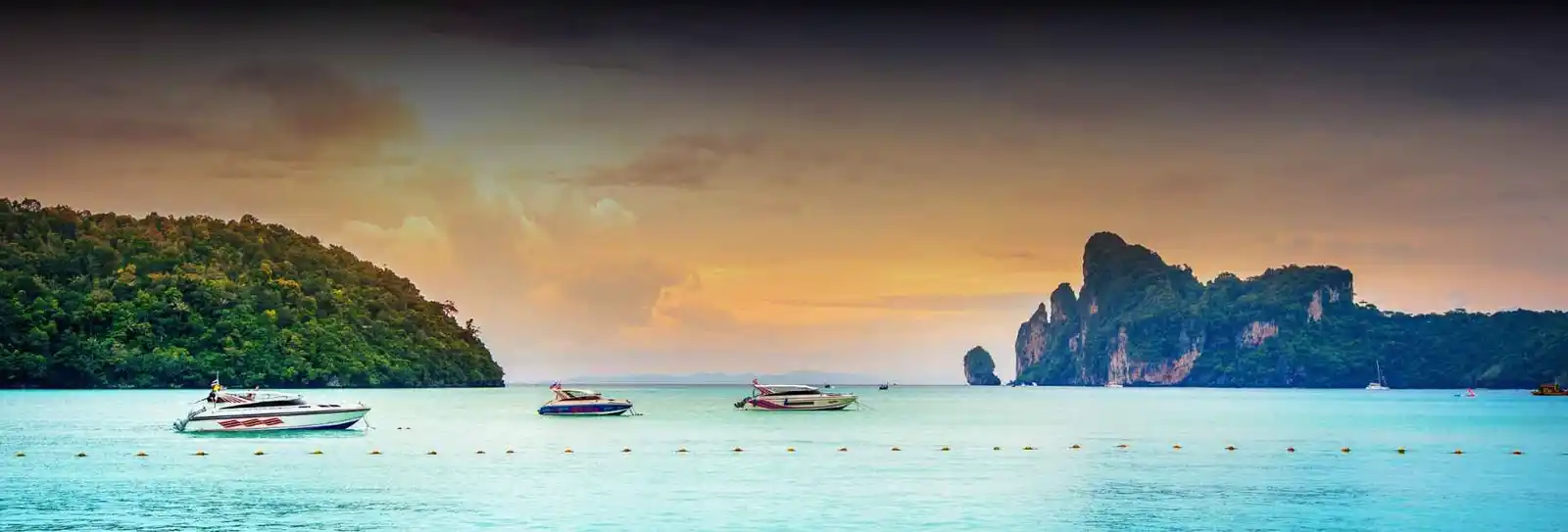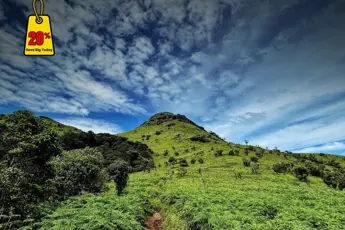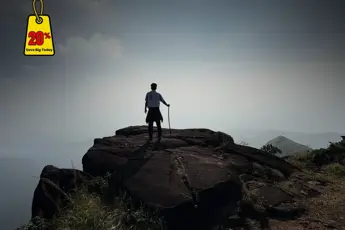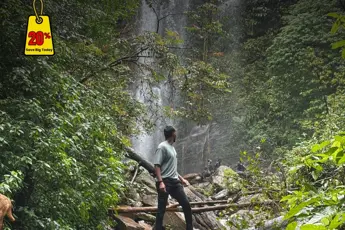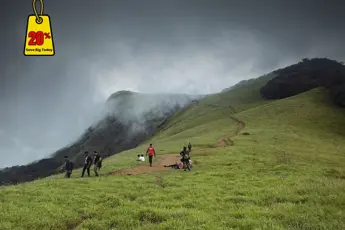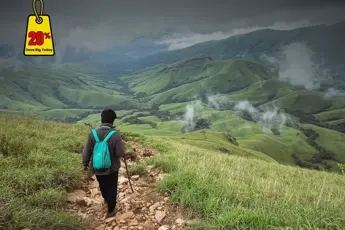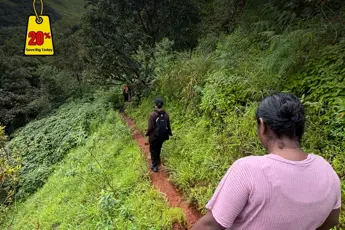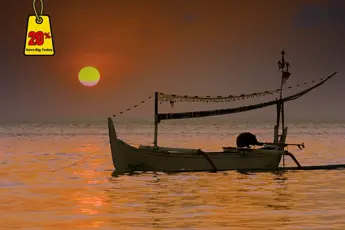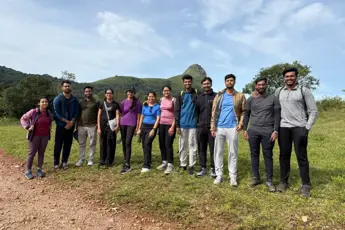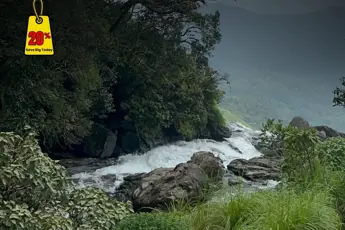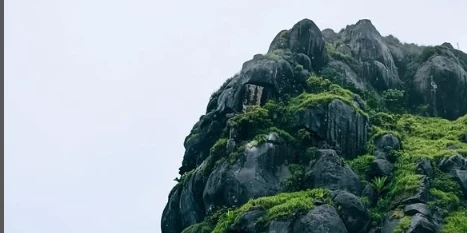
Set amidst the most central area of the Western Ghats of Kudremukh National Park is the Kurinjal Trek, a secret Karnataka gem with an unpolluted mix of nature, tranquillity, and adventure. The moderately difficult trek, situated close to Kudremukh in the Chikmagalur district, is perfect for novices as well as seasoned adventurers who would like to discover the untouched nature of the Western Ghats. The walk is approximately 7 kilometres in one way and would typically take 4–5 hours to trek around in a round-trip mode, depending on the speed and weather. The Kurinjal Trek is about walking through green woods, grasslands, and foggy valleys and takes place with a bird's eye view of the surrounding hills. The trek is full of biodiversity and also in a protected area, and one would thus require a Forest Department permit to proceed.While going up, you're blessed with birdsong, rustling of leaves in the wind, and now and then catching brief glimpses of some exotic plant and animal life. At the top, there is a wide panorama of Kudremukh hills and the rolling landscape of the national park in store for you, which is a treat. What makes the this Trek unique is its serene and quite unconventional path, far from tourist throngs. It's just the thing for nature enthusiasts, photographers, and trekkers looking for a serene yet challenging trek. The best season to perform the Kurinjal Trek is post-monsoons, i.e., September to February, when there is a green surrounding, blue sky, and cold weather. Whether you’re looking for a weekend adventure or a soul-refreshing getaway, the Kurinjal Trek promises an immersive experience in one of Karnataka’s most pristine natural settings. Don’t forget to carry essentials like water, snacks, good trekking shoes, and a camera to capture the magic of the Western Ghats.History of Kurinjal TrekThe Trek falls under the jurisdiction of the Kudremukh National Park, an area well conserved in ecological and cultural regard. The hill itself may not have the well-documented history that some of Karnataka's more seasoned fort treks can claim, but the region as a whole has a good association with local myth and ecological conservation. Kudremukh, also known as "horse-face" in Kannada (after the appearance of one of its peaks), was a block of iron ore mine belonging to and operated by the Kudremukh Iron Ore Company Limited (KIOCL) in the latter part of the 20th century. But with nature almost becoming extinct and collective efforts from the conservationists, mining was stopped in the early 2000s. The area, Kurinjal included, has been under the shadow of the Kudremukh National Park ever since. The park has been a national park since 1987 and a biodiversity hotspot under the Western Ghats UNESCO World Heritage Site. The trail, along with the rest of the trails in the area, was initially covered by native tribes and villagers from village to village.They were subsequently found by trekkers and nature lovers, who were attracted by the region's virgin forests, shola grasslands, and sheer majesty. Today, access is controlled by the Forest Department to limit the number of visitors and maintain its dense flora and fauna. Not a traditional historic hike in the form of an old temple or fort at the top (there isn't one such here), the past of the Kurinjal Trek is a chapter in Karnataka's green revolution, a transition from industrial use to preservation and ecotourism. It's a newer example of nature and an environmentally friendly adventure that exists when preserved and in a pristine state.👉 Looking for a thrilling Monsoon trek from Bangalore? Don’t miss the chance to experience the Kurinjal Trek with Escape2Explore. This guided adventure offers scenic trails, an ancient fort, and breathtaking sunrise views — perfect for weekend getaways and nature lovers.Places near Kurinjal TrekKudremukh Peak: Aside from a path from the base of Kurinjal, Kudremukh Peak is the third-highest point in Karnataka and any trekker's dream. Famous for its horse-headed summit, this trek is slightly more difficult than Kurinjal but worth it with stunning scenery of the Western Ghats. The trek involves going through woods, streams, and grasslands, and nature lovers experience an adrenaline rush and vistas.Hanuman Gundi Falls: Approximately 20 km away lies the peaceful cascade of Hanuman Gundi Falls in Kudremukh National Park. The waterfall falls a distance of approximately 22 meters between thick forests and rugged land. It is a perfect destination to unwind after trekking, take a nature walk, or just enjoy nature's peaceful forest surroundings. The waterfalls are at their best during or immediately after monsoonsLakhya Dam: Lakhya Dam is located near the town of Kudremukh and was constructed over the Lakhya River. It was also used earlier for the operations of the iron ore mine. Although no longer used for boating and water sports activities, the dam site is calm, serene, and an ideal location to spend some time, taking some pictures on your trip.Kalasa: Approximately 40 km away is Kalasa, a small temple town situated on the River Bhadra. It is famous for the Lord Shiva temple, Kalaseshwara Temple, coffee plantation, and Malnad cuisine and is hence a rightful cultural and culinary diversion.Horanadu: Only 50 km away is the Annapoorneshwari Temple at Horanadu, the most popular sacred pilgrim destination. Nestled in beautiful green landscapes, the serene environment, free food for the visitors, and a peek into the spirituality of Karnataka create the perfect destination to conclude your quest in a serene frame of mind.Best Times to Visit Kurinjal TrekPost-Monsoon (September to November) – The best time to trek is in this season. Post-monsoon, the entire region gets covered with lush green forests, fresh air and blue sky. The weather is soothing, and the view is at its peak; the trek route becomes photo-friendly and view-friendly. There are chances of seeing wildlife as well as endemic plants more too, since the forest has come up nicely this season. It is good for wildlife enthusiasts and photographers as well.Winter (December to February) – The Winter season is also a good time to visit the hill, particularly for cold-weather lovers. It will be cold in the morning and evenings, but the sun will be shining bright and warm enough for trekking. Skies are clear with great views from the top. As this is also a comparatively dry season, the trail is not slippery and thus is fun to trek. It is serene and secluded for a serene nature haven. 3. Summer (March to May) – Not trekking-friendly but can be, especially early morning. There is canopy cover to provide shade, but the sun becomes merciless at noon. If you are an early riser and would like to have a less touristy experience without all those other tourists, then summer is an appropriate off-season option. Just be sure to bring loads of water, sunscreen, and light clothes.Monsoon (June to August) – Monsoon makes the trail a green paradise, but it comes with leeches, slippery trails, and heavy rain too. Trekking is for the brave here and must be avoided unless by an experienced trekker with proper equipment. The Forest Department may also block the entrance during heavy monsoon to safeguard tourists and the ecosystem.How to Reach Kurinjal TrekBy Road – The Trek is road-connected and is best approached by road from nearby major cities like Bangalore, Mangalore, or Chikmagalur. By road distance from Bangalore is approximately 330 km, which would take approximately 7–8 hours of road travel time. It can be driven to from Hassan or travelled to by road via the scenic drive of Chikmagalur. You also have the option of private and government buses plying in the area, as close as Kalasa or Kudremukh village, the nearest. From there, you can go on by local jeep or taxi to the Forest Office, the trek starting point. This is the most scenic and best mode of travel.By Train – The nearest railway station to Kurinjal is Mangalore Junction (about 110 km). Cab or bus travel from the station to Kalasa or Kudremukh. Although there is no direct train to Kurinjal, it is a good option if you are coming from distant cities like Mumbai, Goa, or Chennai. Combine this with road travel from Mangalore for a trouble-free trip.By Airport – Mangalore International Airport (around 120 km from here) is the closest airport. Taxi or bus from the airport to Kalasa or Kudremukh can be arranged. Flights to Mangalore run daily from Indian cities such as Bangalore, Mumbai, Hyderabad, and Delhi. It is the best one for tourists travelling from the northern or eastern regions of India in a bid to conserve time travelling.Why Book with escape2exploreWhen it comes to exploring Kurinjal Trek from Bangalore and beyond, escape2explore stands out as a trusted name in adventure and experiential travel. Here’s why hundreds of travellers choose us for their getaways:Trusted, Well-Reviewed Local Operator: escape2explore has gained the trust of thousands of content tourists all over India. With persistent positive feedback and an unblemished reputation for delivering quality experiences, we assure your experience to be hassle-free, memorable, and value-packed. Our insider local knowledge guarantees that you to always be in safe hands.Seasoned Guides: Our trips are led by friendly, trained, and professional guides who are passionate about the outdoors and your safety. Whether it's a beach trek, a cultural tour, or a spiritual walk through temples, our team knows the terrain, the stories, and how to make each moment count.Safe & Curated Itineraries: Your safety is our number one priority. Each of our tour packages is thoughtfully crafted with safety measures, researched accommodations, and easy travel arrangements. We take care of the details so you can have the experience hassle-free and worry-free.Unique Experience That You Won't Find Anywhere Else: With escape2explore, you discover more than the tourist attractions. We go off the beaten track with hidden beaches, unusual treks, offbeat cultural destinations, and true interactions.Read: Kodachdris|Munnar|Top Places in Munnar|Kodachadri|Netravati


